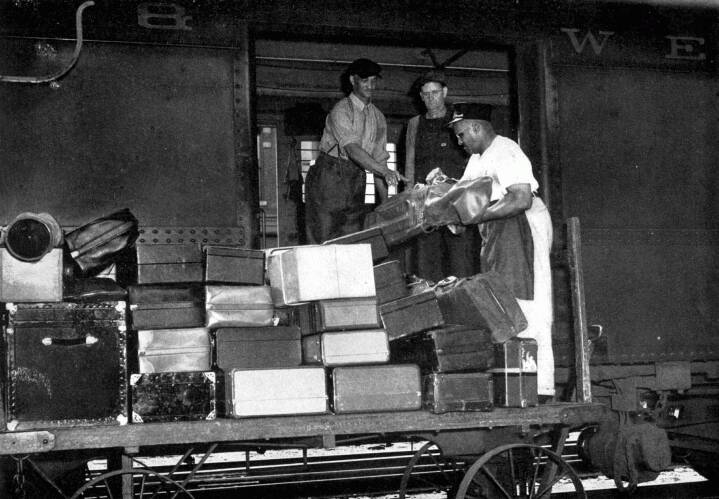 Loading the Baggage Car
Loading the Baggage Car
When brother or sister leaves for college or when mother and
dad go to the seashore they take along their clothes and other
personal belongings. Frequently one or more trunks and several
smaller pieces of baggage are necessary to carry them. It is for
the accommodation of these and other passengers that the railroads
provide special cars in their trains to carry trunks and other
luggage.
Each year the railroads carry hundreds of thousands of trunks
and other hundreds of thousands of pieces of hand luggage for
the convenience of their passengers. The baggage car is also used
for the transportation of dogs, cats, birds in cages, and other
pets accompanying their owners.
In every large railway station there is a baggage room where baggage
is received and checked for forwarding by train or for delivery
to passengers or their agents. A baggage agent or baggage master
is in charge of the handling and storing of baggage. Baggage which
is to be forwarded by train is loaded on electrically operated
trucks or on trailers drawn by electric trucks and hauled to the
proper train for loading. At small stations, baggage and express
parcels are loaded on a platform truck and pulled by hand to the
baggage car door by the baggage agent, or the station agent, or
one of the station assistants. Incoming baggage is handled in
the same manner, except that the movement is reversed.
The baggage car is usually located in the train just behind the
express and mail cars and ahead of the passenger carrying cars.
It has small windows, large doors and lots of storage space. It
is in fact the storeroom for the passenger train.
The railroad employee in charge of the car is called the baggageman.
In addition to looking after the passengers' baggage, the baggageman
sometimes receives and distributes newspapers in bundles. He also
receives, sorts and distributes the railroad company's business
mail passing between railway officers and agents. Railroad business
mail handled in the baggage car does not pass through government
post offices.
While the train is speeding along between stations, the baggageman
arranges the baggage, mail and newspapers in convenient piles,
ready to be put off at the proper stations. The baggageman examines
each piece of baggage to see that it is properly wrapped, locked,
tagged and addressed. He keeps a record of what he takes on and
puts off at each station.
For each piece of baggage received, the baggage agent or his assistant
uses two checks, each bearing identical numbers, one of which
is attached to the baggage, and the other of which is given to
the owner of the baggage as a receipt. The baggage is reclaimed
by the owner upon presentation of the duplicate check.
Many years ago baggage could not be checked over two or more railroads.
But the railroads worked out a plan whereby a passenger can now
check baggage from any city or town in the country to any other
city or town reached by a railroad-in fact, to any point provided
for in the railway ticket, regardless of the number of railroads
the passenger travels over.
For the further convenience of passengers, the railroads have
arrangements with local transfer companies in many cities to call
at the passenger's home hotel or dormitory for baggage and check
it through to any street address at destination.
Passengers are allowed to check 150 pounds of baggage free on
each full-fare ticket, or 75 pounds on each half-fare ticket.
A charge is made for excess weight. There is no limit to the amount
of baggage a passenger may check for shipment, provided charges
for excess weight are paid, but the maximum weight allowed for
any piece of baggage is 300 pounds, and the maximum length permitted
for any piece of baggage is 72 inches. The highest valuation or
risk accepted by the railroads on one passenger's baggage is $2,500.
For the convenience of their patrons, the larger railway stations
also maintain parcel rooms where hand bags, parcels overcoats,
wraps, and other articles may be checked for a charge of 10 cents
for each 24 hours or less. In some stations there are metal lockers
for the same purpose.
I've Been Working
on the Railroad | Contents Page
|







